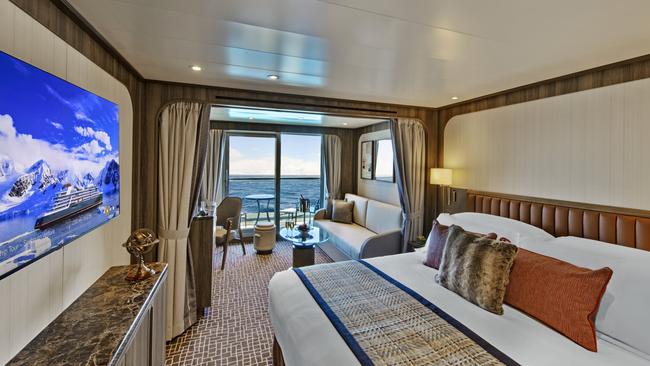A Kimberley expedition – with an expertly made Negroni in hand
The land is as glorious as promised, and completely unspoilt, unlike the ship’s guests, whose every desire is satisfied. This is travel at the confluence of luxury and adventure.

To take the first cruise of your life on the Seabourn Pursuit must be something like having driving lessons in a Rolls-Royce, or eating your first restaurant meal at the Tour d’Argent in Paris: I suspect it spoils you for any subsequent voyage.
Many times I’ve crossed the Sydney Harbour Bridge to find my view of Circular Quay blocked by gigantic vessels named something like “Monster of the Seas”, and never fancied being trapped aboard one with several thousand elderly strangers. It’s a prejudice that’s kept me holidaying on land in contented ignorance all my life, until a few weeks ago the magazine’s editor decided it might be fun to assign a novice to explore the increasingly popular world of expedition cruising.
The great selling point for me was the itinerary: after decades of fascination with the Kimberley region of northwest Australia, I’ve only ever managed to skirt it, handicapped by a wallet that, disappointingly, has never accommodated helicopters.
Over the years I’ve driven as close as hire cars could take me, to Derby, Fitzroy Crossing and Halls Creek, up to Kununurra and a nervous peek at the Gibb River Road; but the bulk of its wild vastness – as big as Spain, but with a thousandth of the population – remained a mystery, especially the legendary beauty and majesty of the region’s coastline, which I assumed would forever elude me.

Then I met the Seabourn Pursuit, just one year old. Moored at the port in Broome, the 170m-long ship couldn’t be further from the floating apartment blocks of my nightmares. Its sleek, elegant lines and tasteful colour scheme are more suggestive of a superyacht, albeit one with room for 264 passengers and a similar complement of crew. We were to spend 10 days tracing the coast round to Darwin, with regular stops for closer encounters with the landscape and wildlife.
Once on board, my fears of entering a cocoon of geriatrics marking their bingo cards in heaven’s waiting room evaporated. Many of these chickens were a lot springier than me, stylishly dressed, chatty, sophisticated and wise to the ways of the sea, miraculously spiriting caviar and champagne out of nowhere (a special Seabourn treat), some even before heading to their suites to unpack their bags.
We were in a standard Veranda suite, although by standard I mean much nicer than our own house. The suites are fitted out like 5-star hotel rooms, with all sorts of ingenious design touches that extract Tardis-like space from a 33 sqm footprint, continuing the luxury-yacht feel. The bed is wide and comfortable, the bathroom bright and elegant with just enough marble, stocked with a variety of exotic Molton Brown lotions (I spent a few days smelling deliciously of ylang ylang, which I had previously assumed was an apelike creature from the jungles of Borneo).

There’s a walk-in wardrobe and a heated drying cupboard for the kit issued on the Antarctic cruises the ship will make during the summer months. And if you want to relax in privacy, every suite has a neat balcony to watch the scenery slide by as you try to empty the Magic Pudding minibar that refills itself while you’re out expeditioning. For this is an expedition ship, and takes its business seriously.
Twice a day, depending on your location, the ship anchors (or rather stops and stays exactly where the captain wants, its position locked to GPS and maintained by a state-of-the-art array of thrusters), whereupon the intrepid guests board the fleet of 24 powerful Zodiacs to patrol the coast or explore deep into the river systems. I say intrepid, but that’s not really true: the crew’s commitment to safety (let’s face it, no one wants Nana to end up in a crocodile’s dining room or clinging to an iceberg in the Southern Ocean) means Zodiac entry and exit is carefully choreographed, and executed with military precision. It means voyagers of any age or agility can participate in these adventures.
You could, if you wanted, stay in bed half the day and eat and drink your way through the boundless food offerings, but I imagine there are more appropriate vessels bobbing around the Caribbean to accommodate that kind of gluttonous lethargy.
The calls for your Zodiac group (we’re all colour-coded on arrival) sometimes come at 7am for an early departure, for we remain at the mercy of the huge Kimberley tides, and while there’s a bedside button to switch off the notifications and remain sleeping, it seems pretty well everyone turns up in their lifejacket bang on time to the exit ports just above the waterline. It’s exhilarating to whip across the brilliant blue water in search of turtles and crocodiles, the spray drying to salt on your skin as the sun rises higher in a cloudless sky.
On one trip our young driver smiled at the simpleton grin I was wearing and said, “Exciting, eh? Have you ever been on one of these before?” I had time to say “Not since my army days, and hardly ever in daylight,” before my wife elbowed me and said something I couldn’t quite catch over the noise of the outboard. Just trying to keep the kids on their toes.


There are two dozen of these expedition guides, boasting a diverse range of knowledge: botanists, marine biologists, herpetologists, historians, geologists, ocean-racing sailors, all patient and charming, even when answering inane questions from their passengers (OK, mostly me). Somehow they avoid becoming the insufferable know-alls I would turn into with half their expertise.
The Zodiac drivers are in constant communication with the ship and each other: it’s like having 48 keen and highly trained eyes scanning your surroundings for you, and to our childish joy they can see through nature’s camouflage to point out anything that crawls, runs or swims.
On the 25km round trip up the King George River to the twin waterfalls (Australia’s highest) that tumble 80m from the escarpment above, you fancy yourself in a David Attenborough documentary, gliding through a winding, golden gorge of honeycombed sandstone, past apparently unconcerned estuarine crocodiles, lizards, wallabies, sharks, mud skippers and crabs.
The water looks tempting, but you lose your desire to leap into it when you see the crocodiles’ slides, gouged into the muddy banks amid the endless stands of mangroves. But at a couple of memorable sandy beaches we step ashore to be greeted by members of the Wunambal Gaambera people, the traditional owners of the sea country of Ngula Jar Island (in Vansittart Bay) and Yirinni (the Hunter River), and the freshwater country of the Mitchell Plateau. They have been appointed godparents of Seabourn Pursuit, whose financial support assists their cultural and artistic endeavours, and enables many of their people to return to and work on their ancient homelands.

It is a rare privilege to be greeted with a warm welcome and smoking ceremony on Jar Island; it’s thrilling to climb among the rocks to a cavernous shelter whose ceiling is adorned with Gwion Gwion rock art; and it’s moving to hear the tales of that art from an Indigenous ranger whose grandmother was removed from her land within living memory.
That land is as glorious as promised, and completely unspoilt, unlike the ship’s guests, whose every desire (within the bounds of decency and legality) is satisfied. Fancy a steak in your suite at 3am? It’s only a non-judgmental phone call away, although the busy schedule of activities tends to limit late-night excess.
There are eight public dining venues, staffed by some of the most agreeable people you could wish to meet, from the casual, outdoor Patio (where they will cook you a deliciously rare burger, something that has almost disappeared on land), through an increasingly refined range of buffet and a la carte in the Colonnade, to fine dining in The Restaurant; and my favourite, the Club lounge, where perfect sushi and sashimi are made to order and the inventive cocktails demand diligent investigation.
All food and drink is included in your fare (apart from some super-premium wines you can pay extra for), and the bars (including my second favourite, the Constellation) featured on our trip a talented duo singing modern classics and, later, the kind of pianist every good lounge should contain.

This, then, is travel at the confluence of luxury and adventure. There may be smaller expedition vessels that offer a more rugged, raw experience of the wild; and there are no doubt ocean-going liners that reach higher peaks of indulgence and excess. But it’s hard to imagine a more judicious combination than the Seabourn Pursuit, a home for voyagers who want a close-up taste of the remote corners of the world – without finding themselves too far from an expertly made Negroni.
Checklist
The Ship: Seabourn Pursuit is purpose-built as an expedition vehicle, designed to handle a range of conditions, from cruising the tropics to the wilds of Antarctica (its hull is strengthened to Polar Class 6, which allows it to cut through 1.2m of new-season ice). It carries two custom-built submarines, 24 Zodiacs, kayaks, and a 24-person Expedition Team.
The Journey: Waterfalls & Wandjinas, the 10-day voyage from Broome to Darwin (or return), visits many of the otherwise inaccessible highlights of the region, including the Horizontal Falls of Talbot Bay, Montgomery Reef, the Hunter River and Ashmore Reef. Kimberley cruises begin again next May, after the ship returns from a summer exploring Antarctica.
The Price: It’s luxury travel, remember. Fares for a verandah suite on an eleven-day Kimberley Expedition: Waterfalls and Wandjinas departing August 13 2025 (voyages of various lengths run between Darwin and Broome from May 30-August 24 2025) start from $16,739 per guest, based on double occupancy. Seabourn.com




To join the conversation, please log in. Don't have an account? Register
Join the conversation, you are commenting as Logout